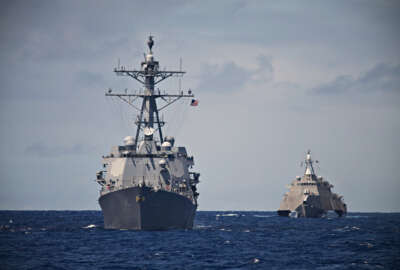Insight by Veritas Technologies and Microsoft Federal
DoD Cloud Exchange 2023: Veritas’ Mike Malaret and Microsoft Federal’s Vishal Amin on cloud resiliency
In a conversation with Federal News Network’s Jason Miller, technology leaders from Veritas Technologies and Microsoft Federal highlight the security benefits...
When it comes to supporting the warfighter with cloud services, resiliency is at or near the top of the Defense Department’s requirements.
DoD technology leaders want to harness the power of the cloud to take advantage of the trillions of data inputs and outputs available, while simultaneously freeing warfighters from having to worry about the consistency of the infrastructure, storage and network.
The department has always had to deal with the volatility of the edge, but hybrid cloud is making those challenges less of a concern, said Vishal Amin, general manager of security solutions for defense at Microsoft Federal.
“Certainly, there are some wonderful capabilities with 5G that allow you to stand up the infrastructure that allows you to connect to cellular infrastructure that’s somewhat global. The security aspects of it are much improved, much hardened. So it really lends itself well to being able to build out hybrid infrastructure,” Amin said during a discussion with Veritas Technologies’ Mike Malaret for Federal News Network’s DoD Cloud Exchange 2023.
Creating resiliency in near-real time
Microsoft considers hybrid infrastructure — whether it’s hybrid edge, primary data centers or high availability across clouds — a key capability that it can bring to its customers, Amin continued.
“The cloud disaster recovery is unique in the backup space. We do it as continuous data protection,” he said. “We can basically predict what our point in time recoveries are usually within 5 minutes. The edge and the latency might actually produce a little bit longer than that.”
Even so, the cloud offers the ability to do rapid recovery to ensure remote users can see the same information as everyone else, which is a critical tactical advantage.
Malaret, technical director for public sector at Veritas Technologies, noted that the hybrid infrastructure being erected DoD must not only be resilient but secure to Impact Level 5 and 6 requirements.
Software and applications therefore must work in the cloud, especially at the edge, while also ensuring resiliency and security, he said.
“It’s really a great bridge between private industry, cloud service providers and the government, which has a unique requirement with the tactical edge,” Malaret said. Veritas intends to offer these capabilities for hybrid situations but natively in the cloud — and eventually as a service, he said.
Shared responsibility in the cloud
Beyond resiliency and security, another capability that hybrid cloud provides is the ability for DoD to better control technology administration and upkeep costs. That’s because the cloud service providers oversee the compliance requirements and ensure innovation as part of the shared responsibility model, Amin said.
Malaret added, however, that DoD and other federal customers must keep in mind that management of the cloud instance remains in their control.
“We’ve seen mass deletions of accounts and identities and groups that have caused some major chaos for customers where they’ve had to be able to do large-scale recoveries. So, we focus on the shared responsibility model from that top end,” he said. “The cloud takes a security-first type model, and you have to have security controls that are available to the customer.”
To read or watch other sessions on demand, go to our 2023 DoD Cloud Exchange event page.
Copyright © 2024 Federal News Network. All rights reserved. This website is not intended for users located within the European Economic Area.
Related Stories
Featured speakers
-

Mike Malaret
Technical Director, Public Sector, Veritas Technologies
-

Vishal Amin
General Manager of Security Solutions, Defense, Microsoft Federal
-

Jason Miller
Executive Editor, Federal News Network
On DoD
Upcoming Events
Related Stories
Top Stories

Mike Malaret
Technical Director, Public Sector, Veritas Technologies

Vishal Amin
General Manager of Security Solutions, Defense, Microsoft Federal

Jason Miller
Executive Editor, Federal News Network
Jason Miller has been executive editor of Federal News Network since 2008. Jason directs the news coverage on all federal issues. He has also produced several news series – among them on whistleblower retaliation at the SBA, the overall impact of President Obama’s first term, cross-agency priority goals, shared services and procurement reform.







